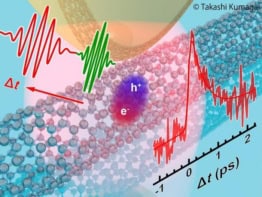
Silicon carbide, a material that is already widely used in high-power electronics, could also be used for quantum information processing. So say researchers in the US who have studied point defects in the material. These defects, similar to ones found in diamond, contain electron spin states that can be controlled coherently and manipulated as quantum bits (qubits) using light.
A quantum computer exploits the ability of a quantum particle to be in a “superposition” of two or more states at the same time. By encoding information into qubits based on such particles, a quantum computer could, in principle, outperform a classical computer on certain tasks. For example, a quantum computer should be good at code decryption, because its processing speed should increase exponentially with the number of qubits involved. In practice, however, physicists have struggled to create even the simplest quantum computer because the fragile nature of these quantum states means that they are easily destroyed and difficult to control.
Recently, diamond-based qubits created a flurry of interest because their “decoherence” time (the time that they can retain their logic state) is much longer than the time it takes to perform a logical operation – even at room temperature. What is more, they can be read-out using light, which means that they could potentially be integrated into photonic quantum-information-processing systems. However, making these qubits remains a challenge – both in terms of cost and scaling-up the technology to make multi-qubit integrated circuits.
Now, in a new paper in Nature, David Awschalom and colleagues at the University of California, Santa Barbara show that similar qubits can be made in silicon carbide. This material is already widely used in the electronics industry and therefore should be easier to scale-up than diamond.
Divacancies
The researchers looked at a specific crystal structure of silicon carbide called 4H-SiC that contains naturally occurring defects called “divacancies”. These correspond to a missing silicon atom next to a missing carbon atom in the crystal. They are very much like the defects in diamond known as “nitrogen-vacancy centres”, which have already been used as qubits. Both types of defect form a multi-electron system that has a net angular momentum (or spin) that can be aligned either parallel (“1”) or antiparallel (“0”) to an applied magnetic field, and can so be exploited as a qubit. Some SiC defects interact with light and have long decoherence times at room temperature – just like those in diamond.
Like previous experiments on diamond nitrogen-vacancy centres, Awschalom and co-workers measured the spin of the divacancies in 4H-SiC using photoluminescence. This involved shining laser light onto the sample and collecting the fluorescence light subsequently emitted by it. And, as for diamond nitrogen vacancies, the fluorescence of the silicon-carbide divacancies depends on their spin state, thus making it possible to read-out the state of the qubits in this way.
Quantum writing
By then applying an oscillating magnetic field at microwave frequencies to the sample, the researchers were able to perform electron spin resonance. Here, the spin of a divacancy oscillated between its two-qubit states, something that can be used to “write” quantum information to the sample. Again, the technique has already been tried and tested in diamond.
While these measurements suggest that SiC could find a role in quantum computing, Andrew Dzurak of the University of New South Wales sounds a note of caution in a related article in Nature. “Although silicon-carbide qubits offer enticing prospects for quantum computing, a number of challenges for this new technology remain. First, the qubit operations reported here were performed on a large ensemble of qubits, so the next step will be to demonstrate control and measurement of a single qubit. More significantly, technologies must be developed to ‘engineer’ thousands of individually addressable divacancy qubits, rather than merely identifying accidentally located defects. Engineering will also be needed to configure pairs of adjacent qubits reliably, to enable controlled two-qubit operations – another vital requirement for quantum computation,” he writes.
However, if these challenges can be met, silicon carbide could become a “serious candidate” for large-scale quantum computing, Dzurak says.
The research is described in Nature 479 84.



